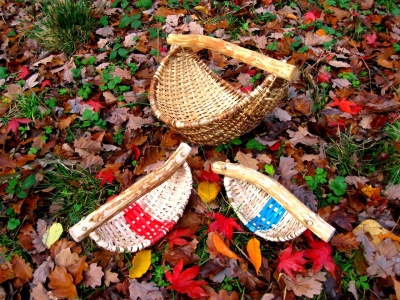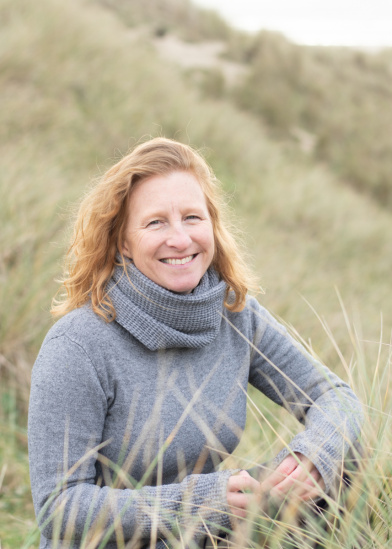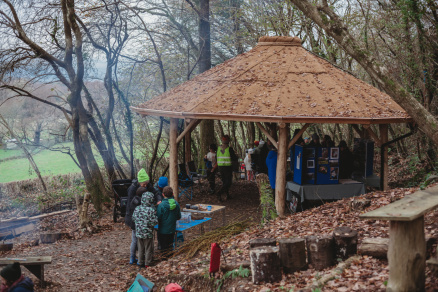
Make a split hazel 'swallow's nest' basket
- The Green Wood Centre
- 05 Jul 2025
11 Mar 2024
We spoke to Jenny Hall, Director of CraftedSpace, about inspirational women and the challenges she has faced as a female architect.

Jenny and her assistant, Karina, (a recent graduate of the master's programme at The Centre for Alternative Technology) worked with Coed Lleol / Small Woods to design three inspiring and versatile woodland hubs at sites in Taliesin, Pantperthog and Pontypridd.
Thanks to funding from Enabling Natural Resources and Wellbeing (EnRAW), these hubs can be used to focus on meeting the needs of local communities for social prescribing, community activity, training and skills development, whilst improving and protecting the local environment.
Jenny trained as a carpenter and joiner after gaining her first degree in architecture, and went on to run building projects as a sole trader. As well as building up her own practice, she has taught women’s building skills at festivals, was a guest tutor at the Wood Program in Helsinki, ran a series of woodland design laboratories with another female architect, and more recently has become a tutor for the ‘Build Week’ at The Centre for Alternative Technology.
Tell us about the Woodland Hubs project and working with Coed Lleol / Small Woods?
It was a huge challenge to undertake these infrastructure improvements in the time frame that was allotted. Within the constraints, we developed a proposal which could adapt to different sites, which doesn’t use any concrete. The buildings are screwed into the ground with metal anchors so they don't impact tree roots.
You could go to the Taliesin Hub tomorrow and take the building away, and you'd never know it had been there.
We also benefited from drawing inspiration from a really successful project in Mid Wales, which is called the Living Room Treehouse Experience, that pioneered a way of building structures underneath the tree canopy. Peter Canham lent us his idea for the roofing material, which is essentially layers of textiles on a waterproof membrane, that allows all the forest leaf and litter to land on top and develop its own ecosystem.

What is your relationship to the outdoors and to woodlands?
I get my strength from spending time in the outdoors. One of the things I really love to do is swim in freshwater lakes and rivers, and the sea at times. But I do prefer the sweet water of the rivers and the lakes. This is pretty much the best thing I can do with my mind and my body. Ideally I run first and then swim in cold water but even then, I'm not in for long if I'm honest!
I have a daily practice of walking with my husband in the morning before work, to set ourselves up for the day. There's this nice concept in Welsh culture, which is called the milltir sgwâr, or square mile. I really enjoy walking the extents of my square mile with these little micro walks. It's how I familiarize myself with the time of the year and the changes of the seasons happening all around us. “
Are there any women that inspire you?
My first inspiration was a female architect called Maya Lin. I first saw her work when I was a teenager in Washington, DC. She's an architect and an artist, and she also built the Vietnam War Memorial, which is an incredible memorial landscape intervention. I was really moved physically by her work. There are many women and many female architects that I'm inspired by now, but maybe not in such a visceral way.
The AJ Climate Champion podcast features the innovative Maria Smith, the Sterling prize winner Annalie Riches and a long time inspiration of mine, the clay Architect Anna Heringer. So, yes, my first inspiration was Maya Lin, but I continue to be inspired by women at the forefront of sustainable architecture.
I’m also hugely inspired by the Economist Kate Raworth’s ‘Donut Economics model’ as well as my friend and economist Beth Stratford’s thesis that ‘Building houses won’t get us out of the housing crisis.’ Everything is connected and young legends like Freya Bruce of Recollective know that and are trying to find ways to repurpose and re-imagine waste.
How did you get involved in architecture with a focus on the outdoors and building in a sustainable way?
I was a builder at the Centre for Alternative Technology about 25 years ago, but I’d already started on my journey towards building sustainably by then. I think a lot of people who've got their eyes wide open as designers and makers as well as in other practices, are aware of living within the ecological limitations of the planet. Wherever you learn that, whether it's inspired by an individual or a lecture or reading a book, or listening to the news, it’s wonderful that more and more people have found their way to wanting to do things better, more sustainably and more socially responsibly.
Doing that well is the hard part. The desire is one thing, actually creating real change is a $64 million question, we are all trying to solve!
I think what got me working outdoors was probably festival culture. Building outdoor structures for people to inhabit at festivals meant I didn't just build permanent buildings, but started getting involved in creating lighter weight, indoor - outdoor, play spaces and ephemeral architecture. That led me down the path of working within the arts which coupled with my interest in sustainability and outdoor spaces, has shaped the work I’ve developed.
There's an early project called Caradoc’s Hideout that I built about 15 years ago. That was probably the first permanent outdoor structure that I designed and built from concept to finish. I had won an arts commission but when I went to speak to the community, it was clear that what they wanted was a space for the young people. And what the kids wanted was a tree house, so I stretched the premise of a piece of artwork as far as I could to give them that. The whole thing is a playground disguised as a building!
What does International Women's Day mean to you?
Being a woman and being a feminist are hugely significant for me. It’s a reminder of what I hold to be important every day. I'm not sure that a single day in the year can do very much more than be a marker for any concern, any struggle, or any imbalance that needs to be addressed. But a marker, a breath, a moment is still valuable.
And yes, I'm a woman, and sometimes it's really hard working in an all -male dominated industry. A lot of working culture is set up to prejudice fairly masculine ways of working. Em Appleton’s '100 ways of Transforming Building Site Culture' is a beautiful place to start re-thinking this! One of the nice things about working on the hubs with Zena Wilmot and Amie Andrews, is that they have never sought to criticize the work of any individual about anything. All they've ever tried to do is raise each other up, raise their projects up and be respectful about the users of the spaces in which they work in order to champion those around them. I think that is fairly rare, actually.
Construction is a really male - dominated industry, which can be a problem. I think every single woman working in architecture is already working hard to address the imbalance of the majority of men building a built environment which is inhabited by everybody.
We need representation from all kinds of diverse people to create worthwhile spaces for humans to live and grow in whilst being respectful of all the other creatures that we share the planet with. We need emotional intelligence and mutual support to build a world worth living in.
Jenny and Karina have contributed the Tapestry Table to the exhibition 'Teulu / Family' which is running at Aberystwyth Arts Centre until June 2024. The Tapestry Table portrays reflections of teatime, play time, immersion in nature, idle bodies, buckets and spades; of mealtimes and picnics outdoors; of memories woven together over time: Teulu / Family at Aberystwyth Arts Centre
You can find more of Jenny's beautiful work here: Craftedspace Architects